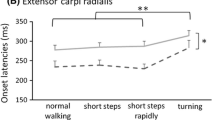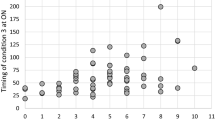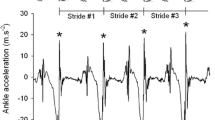Abstract
The ability to carry out two tasks at once is critical to effective functioning in the real world and deficits are termed Dual-task interference or effect—DTE. DTE substantially compromised the gait of subjects with Parkinson’s disease and freezing of gait (PD + FOG), leading to exaggerated slowing, increasing gait dysrhythmicity, and inducing FOG episodes. This study aimed to investigate the DTE in gait variability of subjects with PD and freezing of gait (PD + FOG). Thirty-three patients with PD + FOG and 14 healthy individuals (REFERENCE) took part at this study. Two gait conditions were analyzed: usual walking (single task) and walking while taking the word-color Stroop test (dual task). The computed variables were as follows: gait velocity, step length, step timing, gait asymmetry, variability measures and DTE of each variable. The PD + FOG group has presented negative DTE values for all analyzed variables, indicating dual task cost. The REFERENCE group has presented dual-task benefits for step length standard deviation and step time. Differences between both groups and conditions were found for all variables, except for step time. Taking the word-color Stroop test while walking led to a larger dual-task cost in subjects with PD + FOG.
Similar content being viewed by others
References
Beauchet O, Berrut G (2006) Gait and dual-task: definition, interest, and perspectives in the elderly. Psychol Neuropsychiatr Vieil 4:215–225
Djamshidian A, O’Sullivan SS, Lees A, Averbeck BB (2011) Stroop test performance in impulsive and non impulsive patients with Parkinson’s disease. Parkinsonism Relat Disord 17:212–214. https://doi.org/10.1016/j.parkreldis.2010.12.014
Hsieh YH, Chen KJ, Wang CC, Lai CL (2008) Cognitive and motor components of response speed in the stroop test in Parkinson’s disease patients. Kaohsiung J Med Sci 24:197–203. https://doi.org/10.1016/S1607-551X(08)70117-7
Cohen RG, Klein KA, Nomura M et al (2014) Inhibition, executive function, and freezing of gait. J Parkinsons Dis 4:111–122. https://doi.org/10.3233/JPD-130221
Kelly VE, Eusterbrock AJ, Shumway-Cook A (2012) The effects of instructions on dual-task walking and cognitive task performance in people with Parkinson’s disease. Parkinsons Dis https://doi.org/10.1155/2012/671261
Spildooren J, Vercruysse S, Desloovere K, et al (2010) Freezing of gait in Parkinson’s disease: the impact of dual-tasking and turning. Mov Disord 25:2563–2570. https://doi.org/10.1002/mds.23327
Yogev G, Giladi N, Peretz C et al (2005) Dual tasking, gait rhythmicity, and Parkinson’s disease: which aspects of gait are attention demanding? Eur J Neurosci 22:1248–1256. https://doi.org/10.1111/j.1460-9568.2005.04298.x
Hausdorff JM, Schaafsma JD, Balash Y et al (2003) Impaired regulation of stride variability in Parkinson’s disease subjects with freezing of gait. Exp Brain Res 149:187–194. https://doi.org/10.1007/s00221-002-1354-8
Nanhoe-Mahabier W, Snijders AH, Delval A et al (2011) Walking patterns in Parkinson’s disease with and without freezing of gait. Neuroscience 182:217–224. https://doi.org/10.1016/j.neuroscience.2011.02.061
Plotnik M, Giladi N, Balash Y et al (2005) Is freezing of gait in Parkinson’s disease related to asymmetric motor function? Ann Neurol 57:656–663. DOI: https://doi.org/10.1002/ana.20452
Plotnik M, Giladi N, Hausdorff JM (2008) Bilateral coordination of walking and freezing of gait in Parkinson’s disease. Eur J Neurosci 27:1999–2006. https://doi.org/10.1111/j.1460-9568.2008.06167.x
Plotnik M, Hausdorff JM (2008) The role of gait rhythmicity and bilateral coordination of stepping in the pathophysiology of freezing of gait in Parkinson’s disease. Mov Disord 23:S444–S450. https://doi.org/10.1002/mds.21984
Peterson DS, King LA, Cohen RG, et al (2016) Cognitive contributions to freezing of gait in Parkinson disease: implications for physical rehabilitation. Phys Ther 96:659–670. https://doi.org/10.2522/ptj.20140603
Nutt JG, Bloem BR, Giladi N, et al (2011) Freezing of gait: moving forward on a mysterious clinical phenomenon. Lancet Neurol 10:734–744. https://doi.org/10.1016/S1474-4422(11)70143-0
Wu T, Hallett M, Chan P (2015) Motor automaticity in Parkinson’s disease. Neurobiol Dis 82:226–234. https://doi.org/10.1016/j.nbd.2015.06.014
Fling BW, Cohen RG, Mancini M et al (2014) Functional reorganization of the locomotor network in Parkinson patients with freezing of gait. PLoS One 9:e100291. https://doi.org/10.1371/journal.pone.0100291
Rochester L, Galna B, Lord S, et al (2014) The nature of dual-task interference during gait in incident parkinson’s disease. Neuroscience 265:83–94. https://doi.org/10.1016/j.neuroscience.2014.01.041
Parkinson’s Disease: National Clinical Guideline for Diagnosis and Management in Primary and Secondary Care. London: Royal College of Physicians of London 2006
Folstein MF, Folstein SE, McHugh PR (1975) Mini-mental state. A practical method for grading the cognitive state of patients for the clinician. J Psychiatr Res 12:189–198
Goetz CG, Tilley BC, Shaftman et al (2008) Movement disorder society-sponsored revision of the unified Parkinson’s disease rating scale (MDS-UPDRS): scale presentation and clinimetric testing results. Mov Disord 23:2129–2170. https://doi.org/10.1002/mds.22340
Hoehn MM, Yahr MD (1967) Parkinsonism: onset, progression and mortality. Neurology 17:427–442
Giladi N, Shabtai H, Simon ES, et al (2000) Construction of freezing of gait questionnaire for patients with Parkinsonism. Parkinsonism Relat Disord 6:165–170
Ounpuu S, Gage JR, Davis RB (1991) Three-dimensional lower extremity joint kinetics in normal pediatric gait. J Pediatr Orthop 11:341–349
Almeida QJ, Lebold CA (2010) Freezing of gait in Parkinson’s disease: a perceptual cause for a motor impairment? J Neurol Neurosurg Psychiatry 81:513–518. https://doi.org/10.1136/jnnp.2008.160580
Okada Y, Fukumoto T, Takatori K, et al (2011) Abnormalities of the first three steps of gait initiation in patients with Parkinson’s disease with freezing of gait. Parkinsons Dis https://doi.org/10.4061/2011/202937
Kelly VE, Janke AA, Shumway-Cook A (2010) Effects of instructed focus and task difficulty on concurrent walking and cognitive task performance in healthy young adults. Exp Brain Res 207:65–73. https://doi.org/10.1007/s00221-0102429-6
Plummer P, Eskes G (2015) Measuring treatment effects on dual-task performance: a framework for research and clinical practice. Front Hum Neurosci 9:1–7. https://doi.org/10.3389/fnhum.2015.00225
Taylor R (1999) Interpretation of the correlation coefficient: a basic review. JDMS 1:35–39
Bond JM, Morris M (2000) Goal-directed secondary motor tasks: their effects on gait in subjects with Parkinson disease. Arch Phys Med Rehabil 81:110–116
Hausdorff JM, Nelson ME, Kaliton D et al (2001) Etiology and modification of gait instability in older adults: a randomized controlled trial of exercise. J Appl Physiol 90:2117–2129
Hausdorff JM, Rios DA, Edelberg HK (2001) Gait variability and fall risk in community-living older adults: a 1 year prospective study. Arch Phys Med Rehabil 82:1050–1056. https://doi.org/10.1053/apmr.2001.24893
Holmes JD, Jenkins ME, Johnson AM, et al (2010) Dual-task interference: the effects of verbal cognitive tasks on upright postural stability in Parkinson’s disease. Parkinsons Dis https://doi.org/10.4061/2010/696492
Author information
Authors and Affiliations
Corresponding author
Ethics declarations
Conflict of interest
The authors declare that they have no conflict of interest
Human and animal rights
All procedures performed in studies involving human participants were in accordance with the ethical standards of the institutional and/or national research committee and with the 1964 Helsinki Declaration and its later amendments or comparable ethical standards.
Informed consent
The present study complied with ethical standards and participants provided informed consent.
Rights and permissions
About this article
Cite this article
Kleiner, A.F.R., Pagnussat, A.S., Prisco, G.d. et al. Analyzing gait variability and dual-task interference in patients with Parkinson’s disease and freezing by means of the word-color Stroop test. Aging Clin Exp Res 30, 1137–1142 (2018). https://doi.org/10.1007/s40520-017-0862-0
Received:
Accepted:
Published:
Issue Date:
DOI: https://doi.org/10.1007/s40520-017-0862-0




